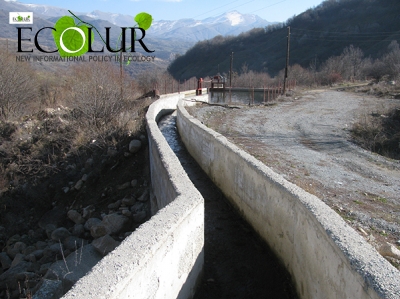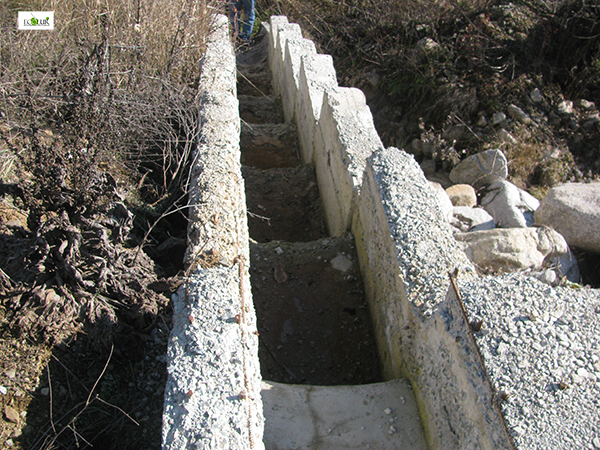

EcoLur
In the framework of the project entitled “Support to SHPP-relating Reforms Through the Dialogue of Public and RA Nature Protection Ministry for Sustainable Use of River Ecosystems” the expert group visited “Kantegh” SHPP. “Kantegh” SHPP is located in Syunik Region, in the administrative area of Litchq Community. The SHPP carries out water intake from Litchq and Arevik tributaries of the Meghri River. It’s operated by “Gelieguzan” LLC.
As a result of the monitoring, the expert group found out:
- “Kantegh” SHPP is adjacent to “Arevik” National Park, some of its structures are even located in the very area of the park.
- At the moment of observation, the SHPP was not operating.
- According to the company, the static pressure of the SHPP is 222.5 m, according to the certificate issued by the Public Services Regulatory Committee on 1 January 2016, the estimated pressure of the SHPP is 205.8 m. According to the project and the PSRC certificate, the estimated yield used by the SHPP is 2.5 m3/s. According to the PSRC certificate, the projected capacity is 4200 kW. According to the PSRC, as of 01.01.2016 the factual useful delivery of the electricity is 6.785 million kWh, the estimated production of the SHPP is 12.94 million kWh, according to the project, duration of license - 15.08.2013- 15.08.2028, water usage permit - 04.11.2013-04.11.2016.
- The real coordinates of the water intake comply with the coordinates mentioned in the water permit, but it’s not true about the water discharge coordinates.
- There are two water intake sections constructed on the Arevik and Litchq tributaries to the Meghri River to carry out water intake for the SHPP. The length of the dam constructed on the Litchq tributary is 8 meters, its height is 1.5 meters. The dam is made of concrete combines with pipes. The length of the dam constructed on the Arevik tributary is 10 meters, its height is 2 meters. The dam is made of concrete combines with pipes.
- There is a stair-like fish passway constructed in the head section of Litchq tributary of the SHPP, which is 8.45 meters long, 1.15 meters high and 0.45 m wide. The fish passway consists of 5 stairs, each of which has height of 0.35 m. The lower part of the fish passway is a halved metallic pipe of 2.3 m long. At the moment of observation, the entrance of the fish passway is blocked with stones and there was no water flowing. There is a stair-like fish passway constructed in the head section of Arevik tributary of the SHPP, which is 9. 5 meters long, 1.9 meters high and 0.5 m wide. The fish passway consists of 7 stairs, each of which has height of 0.2-0.3 m. The lower part of the fish passway is a halved metallic pipe of 2.9 m long. At the moment of observation, there was no water flowing. Even if water flowed there, the fish wouldn’t be able to flow into the fish passway, as its height from the riverbed, which was almost deprived of water, is over 80 cm. The fish-protecting structures of the SHPP have no essential significance for the preservation of the fish species living in the river, while the dams constructed on the riverbed are an obstacle for the seasonal and reproduction migration of the fish.
- There are garbage-collectors available in both head sections of the SHPP, but there are no fish-protecting nets.
- You can meet mainly brown trout in the upper reach of the Meghri River, where SHPP head sections are constructed. Kura barbell may flow up here.
- According to the project, the length of the derivation pipeline in the head section of Litchq Tributary is 1090 meters, its diameter – 720 mm, the length of the derivation pipeline in the head section of Arevik Tributary is 3200 meters, its diameter – 1200 mm. The water from the Litchq River is transferred through the pipeline to the water intake point located on the Arevik tributary, where the water of the Arevik Tributary is also collected. From here the water of both tributaries are collected through the pipeline into the station building.
- According to the water usage permit, water intake of 61495.2 cum water may be implemented in 12 months from both tributaries ensuring an environmental flow of 0.014 cum/s in the Arevik Tributary and an environmental flow of 0.02 cum/s in the Litchq Tributary.
- The automated management and recording of the environmental flow is not ensured.
- There is no water-meter sealed by a relevant environmental body in the water intake.
- There is no automated water intake management system available.
- There are 3 hydroaggregates of Chinese production installed in the SHPP building.
- The transformer substation is fenced, the transformers are not equipped with oil-collecting system.
- The station area is improved, but not greened: there are newly planted trees.
- The water-proof well designed for the discharge of household wastewater was in construction process.
- According to “Computation Center” CJSC data, in 2014 “Kantegh” SHPP operated for 11 months and produced 6784800 kW electricity.
Conclusion
At the moment of observation, the SHPP was not operating because of lack of water in the tributaries. The hydrological data are incorrect. Water was taken from the head section also from the extra drinking water taken by the pumping station.
Proposals
- To completely reconstruct two water intake sections and fish passways to ensure sufficient water amount for the migration of the fish in the fish passways in low-water season and to ensure environmental flow in the river. Before that, the constructions blocking the entrance of the fish passway shall be removed. The use of the dam may be refused and to carry out the water intake in another way without blocking the riverbed.
- To review hydroeconomic estimates with a tendency to increase environmental flow.
- To ensure automatic management of environmental flow in the head section, installation of water-measuring devices and online control.
- To ensure solutions to the discharge of the wastewater through a water-proof well or “mini” cleaning station.
- To equip the transformers with oil-collecting system.
Water intake section in Lichq river
 |
 |
 |
 |
 |
 |
 |
Water intake section in Arevik river
 |
 |
 |
 |
 |
 |
 |
 |
 |
The material was developed in the frames of “Supporting reforms in the sector of small hydro power plants through enabling a dialogue between civil society and the Ministry of Nature Protection for sustainable use of river ecosystems” supported by UNDP/GEF Small Grants Programme".
April 26, 2016 at 18:35
